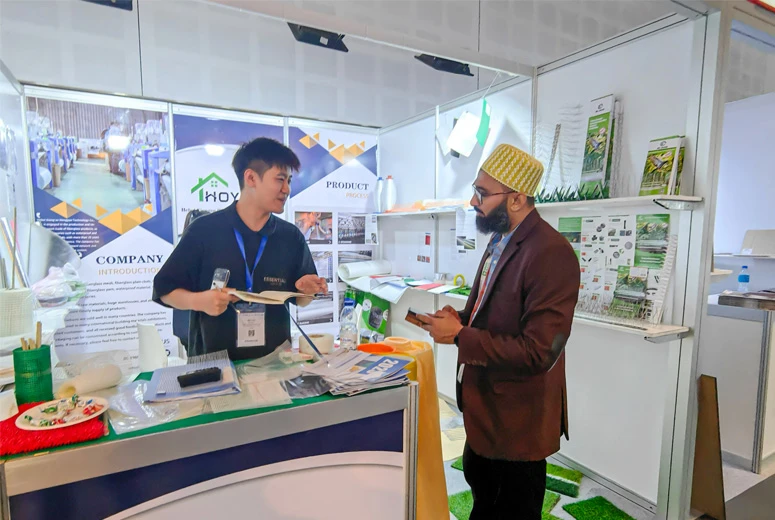
- Afrikaans
- Arabic
- Belarusian
- Bengali
- Czech
- Danish
- Dutch
- English
- Esperanto
- Estonian
- Finnish
- French
- German
- Greek
- Hindi
- Hungarian
- Icelandic
- Indonesian
- irish
- Italian
- Japanese
- kazakh
- Rwandese
- Korean
- Kyrgyz
- Lao
- Latin
- Latvian
- Malay
- Mongolian
- Myanmar
- Norwegian
- Persian
- Polish
- Portuguese
- Romanian
- Russian
- Serbian
- Spanish
- Swedish
- Tagalog
- Tajik
- Thai
- Turkish
- Turkmen
- Ukrainian
- Urdu
- Uighur
- Uzbek
- Vietnamese
playing football on artificial turf
Dec . 01, 2024 11:23 Back to list
Playing Football on Artificial Turf Advantages and Challenges
In recent years, artificial turf has become increasingly popular in the world of football (soccer). It has revolutionized the way the game is played and experienced, offering both advantages and challenges. This article explores the benefits of playing football on artificial turf, the potential drawbacks, and how it shapes the future of the sport.
The Advantages of Artificial Turf
One of the primary benefits of artificial turf is its durability. Unlike natural grass, which can be susceptible to wear and tear from heavy foot traffic and adverse weather conditions, artificial surfaces are designed to withstand intensive use. This durability means that teams can practice and play more frequently without the fear of damaging the field. Consequently, this can lead to improved skill development and competitive performance.
Another advantage is the consistent playing surface that artificial turf provides. Natural grass can be uneven, with patches of dirt or mud affecting how the ball rolls and how players can move. In contrast, artificial turf offers a uniform surface that ensures predictability in gameplay. This consistency can enhance the quality of play and allow players to perform at their best, regardless of weather or field conditions.
Artificial turf also allows for extended playing seasons. In many regions, inclement weather can limit the use of natural grass fields. Heavy rain or snow can render a field unplayable for days or even weeks. However, artificial surfaces can drain water effectively and remain playable in various weather conditions. This means that teams can practice and compete year-round, something that is particularly beneficial in areas with harsh climates.
Cost-effectiveness is another factor to consider. While the initial installation of artificial turf can be expensive, maintenance costs over time are generally lower compared to natural grass. Natural fields require regular upkeep, including mowing, watering, fertilizing, and reseeding. In contrast, artificial turf typically only needs periodic cleaning and infill replacement, making it a more affordable option for many sports facilities.
playing football on artificial turf

The Challenges of Playing on Artificial Turf
Despite its many advantages, playing football on artificial turf does come with its challenges. One of the most significant concerns is player safety. Some studies suggest that the injury rates, particularly for knee and ankle injuries, may be higher on artificial surfaces than on natural grass. The firmer surface can lead to increased impact on joints, and the type of material used can also affect traction. This has prompted discussions among players, coaches, and sports organizations regarding the importance of ensuring that artificial fields meet specific safety standards.
Another issue is the heat retention of artificial turf. In hot weather, the temperature of the turf can rise significantly higher than that of natural grass, making it uncomfortable and potentially hazardous for players. This can lead to increased risk of heat-related illnesses, especially during summer matches or training sessions. Consequently, it is essential for players and coaches to remain vigilant about hydration and take precautions when playing in high temperatures.
Additionally, the environmental impact of artificial turf has raised concerns. While it provides durability and cost savings, many artificial surfaces are made from petroleum-based products, which can contribute to environmental degradation. Manufacturers are exploring eco-friendly alternatives, but the challenge remains in balancing the benefits of artificial turf with its ecological footprint.
The Future of Artificial Turf in Football
As sports technology continues to advance, the future of artificial turf in football looks promising. Innovations in materials and design are leading to the development of safer and more sustainable options. Research is ongoing to address injury concerns and enhance the performance characteristics of artificial surfaces. With the right advancements, it is possible that many of the challenges currently associated with artificial turf can be mitigated.
In conclusion, playing football on artificial turf offers numerous advantages, including increased durability, consistent playability, extended seasons, and cost-effectiveness. However, challenges related to player safety, heat retention, and environmental impact must also be addressed. As the sport evolves, it will be crucial for stakeholders, including players, coaches, and organizations, to engage in discussions that prioritize player welfare and ecological responsibility while enjoying the benefits that artificial turf brings to the beautiful game.
-
The Benefits of Artificial Turf for Indoors
NewsJul.15,2025
-
How Artificial Grass Suppliers Ensure Quality Products
NewsJul.15,2025
-
Artificial Grass and Pets: A Space for Relaxation
NewsJul.08,2025
-
Balcony & Outdoor Decoration with Artificial Grass
NewsJul.08,2025
-
Best Indoor Artificial Grass for Home
NewsJul.07,2025
-
Best Pet Turf for Dogs: Safe & Durable Artificial Grass Options
NewsJul.07,2025
Products categories









